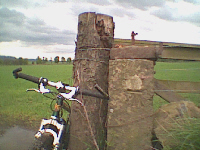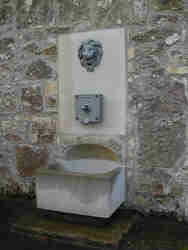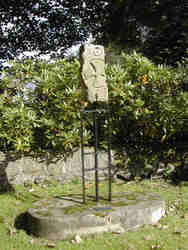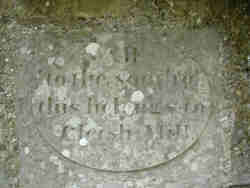
Surveyors mark
Noticed this one on the road between the B9097 and Kinross, on the right after the junction for Hatchbank Road, carved onto an old stone gate post.
This is the benchmark symbol made by the Ordinance Survey surveyors in the days before GPS (Global Positioning Satellites) and aerial mapping.
The distances, angles and elevations would be measured on the ground and the information entered onto a map. The survey points would be marked with a benchmark symbol so the surveyors could use consistent points for their measurements.
These symbols can be found in all manner of places — one can be seen on the wall of the old Kinross County Buildings, opposite the Kirklands Garage. That one has an unusual lead and more precise horizontal datum mark.
 The
surveyors mark on the gatepost
The
surveyors mark on the gatepost
 The
mark
The
mark
Drinking fountain
Public drinking fountains have gone out of fashion these days and it is refreshing to see an old one restored to its former glory. The restoration was part of a"Best kept village" initiative.
 The drinking fountain
The drinking fountain
Cleish Church.
A Fragment of a stone cross was discovered near the village. The cross has been mounted on a steel frame and is displayed in the parish churchyard.
"The stone formed the centre piece of a free standing 13-14th century cross, found at Cleish in 1980 and may have had links with the Cleish chapel, which came under the care of Dunfermline Abbey in 1208."
A set of lamps on the gates to the church bears an inscription that they were switched on by the then MP for Kinross-shire, (Sir) Alec Douglas-Home (1903-1995). Followers of Modern History will realise that "old chalky" became Prime Minister in 1963 after the fall of the MacMillan Government and a life peer in 1974.(Isn't MS Encarta wonderful?)
 The
centre boss of the Celtic cross.
The
centre boss of the Celtic cross.
There is a curious inscription on the wall of the churchyard to the west of the cross. The oval stone proudly proclaims that, "All to the south of this belongs to Cleish Mill." Going by the style of the lettering I would estimate the date of this proclamation to be 18th century. I would love to know why it was necessary to have made this declaration.
The stone can be seen to the left as you enter the churchyard on the western wall.
 The boundary stone
The boundary stone